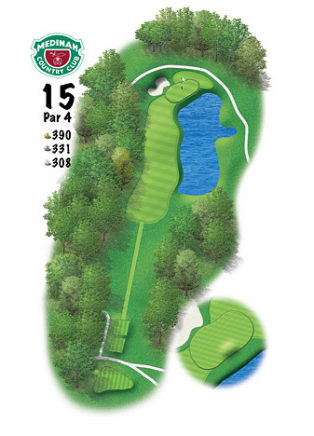Medinah’s New 15th Will Give Pros A Difficult Decision, And May Decide The Outcome
Courtesy of Cameron Morfit
Golf Magazine

There is little disagreement that Medinah’s totally reimagined, driveable par-4 15th hole will provide additional thrills and spills at the Ryder Cup. Rees Jones lopped 100 yards off the hole — it can now play as short as 280 yards — and added a two-acre lake to catch misses to the right. Momentum-swinging eagles beckon. So do watery disasters.
“You can see a lot of things on that hole,” says Europe’s captain, Jose Maria Olazabal.
The question for U.S. Captain Davis Love III is how to set up the hole — a question that is especially resonant in light of what happened at Celtic Manor’s 15th hole, another driveable par 4, at the 2010 Ryder Cup. Although the hole played 377 yards on the card, the tees were pushed up to make it a mere 246-yard carry over the trees. Dustin Johnson, it seemed, would be able to stick the green with a long iron. Ditto for Bubba Watson. Big-hitting Team America would surely leverage its length advantage off the tee to dominate the hole and retain the Cup.
It didn’t happen. Maybe it was the hazard left, or the tall grass right, or the bunkers — for the Yanks there was something about 15. Entering the singles, they had yet to win the hole, with 10 halves and five losses. Steve Stricker finally won 15 with an eagle in his victory over Lee Westwood, but the hole kept creating problems for the visitors. In his halved singles match with Rory McIlroy, Stewart Cink drove the green, left his 20-foot eagle try almost three feet short, then missed again. McIlroy birdied from the sand to pull even, and the two halved their way into the clubhouse.
Although Hunter Mahan’s singles loss to Graeme McDowell got more ink, Celtic’s 15th hole was more of a deciding factor in Europe’s one-point victory. Which means Love must ensure his side avoids the same fate at Medinah.
“We have to decide where we want to put the tee and how we want to play it,” Love says. “I’m sure [PGA Director of Championships] Kerry Haigh will lead us in the right direction of how to set the course up to make it exciting.”
Perhaps Love should ask Paul Azinger, who set up Valhalla to favor long-hitting J.B. Holmes and friends in ’08. Holmes made six birdies to beat Denmark’s Søren Hansen 2 and 1, after which a shell-shocked Hansen said, “He hit it quite long. But quite long is probably an understatement. He hit it really long.”
No matter what Love and Haigh do to 15, strategies will vary. In fourball (best-ball) play, says six-time Ryder Cupper Padraig Harrington, the first player to hit should go for it. “The second guy can always lay it up,” he says. In foursomes (alternate-shot) and singles, though, the penalty for a miss, especially a right miss, where water lurks, will be stiffer. Players who are two (or more) down may go for it anyway.
“A hole like that is very much dependent on the situation,” Harrington says. “Take the 10th hole at the Belfry, which is probably one of the greatest Ryder Cup holes ever. I’ve laid it up at times, and I’ve gone for it at times.”
It’s a game-time decision for the players, and at Medinah one player’s decision at No. 15 might just decide the whole ball game.
The Temptress
Rees Jones, who redesigned Medinah’s 15th, explains how a 280-yard par 4 can still pack a punch.
CHUTE TO THRILL: The opening to the green is 20 yards wide, but it plays more like 12 yards. “Anything on the left side of it falls off into the bunker,” Jones says.
HERE’S THE SKINNY: Even the cautious play from the tee is no gimme. “If they play it safe—2-iron, wedge—it’s the narrowest landing area on the course,” Jones says.
ON THE TEE: The hole can play as long as 330, but Jones says Love will probably play it in the 290-300 range. “He hasn’t decided what to do yet,” Jones says.
SAFETY IN THE SAND: If players miss, they’ll want to miss left, and not just because of the water right. The bunker, Jones says, provides one of the best chances to get up and down.
MULTIPLE CHOICE: The area around the green is closely mown, so the players will have to “manufacture a shot from there,” Jones says. “You’ll see them chip it or bump it or putt it.”
ROLL CALL: The back half of the green pitches toward the water, while the front half runs toward the fairway. “The tougher putt is from back to front,” Jones says. “It’s harder to stop the ball.”
BOMBS AWAY: The 15th will entice players to hit a heroic tee shot.